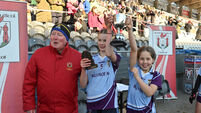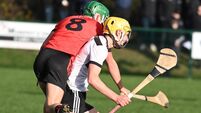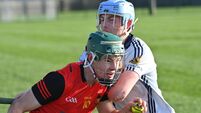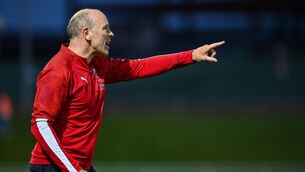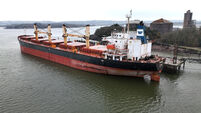Paul Rouse: the myth that those who preferred other sports than Gaelic games played no part in Irish freedom fight
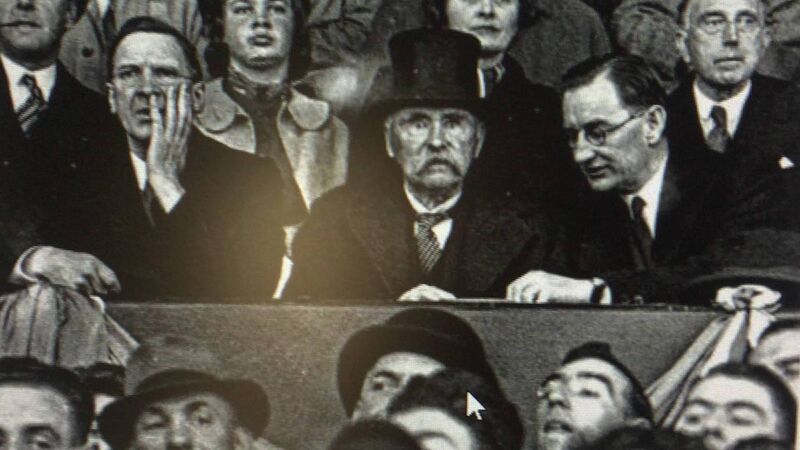
POLITICAL FOOTBALL: President of Ireland, Douglas Hyde (centre) with Eamon De Valera (left) and Oscar Traynor (right) watch the Ireland v Poland soccer match at Dalymount Park in 1938.
The Civil War was a nasty, murderous episode in Irish history. In its course, both sides disgraced themselves with actions that were entirely unacceptable. It is true that the scale of death pales beside civil wars in other countries, either contemporaneously or more recently. But there was brutality nonetheless that has left a stain, 100 years on.
Such is the cultural significance of sport that it was encompassed within the story of those years, 1922 and 1923. Mostly, the stories told relate to how Gaelic football went some way towards healing the wounds of the war, notably in Kerry.
But there is another story from those years which is documented in an excellent article in the international academic journal ‘Soccer & Society’ by Aaron Ó Maonaigh.
In the course of this article, Ó Maonaigh set out the sporting preferences of both sides of the Irish Civil War – and what he had to say was a further demolition of the mythology of the period.
In this mythology, it was repeatedly claimed – by politicians and GAA officials alike – that the GAA was central to the fight for Irish freedom. As the island lurched towards civil war 100 years ago, JJ Walsh – one-time chairman of Cork County Board and then a minister in the first government of the Irish Free State – claimed in Dáil Éireann that the members of the GAA “had been the principal contributors in the fight against England. I think you will all agree with that.”
Later, the anonymous author of ‘Sixty Glorious Years: The Authentic Story of the G.A.A.’ (1946), claimed that “efforts were, indeed, made to recruit G.A.A. men for the British Army, an especial appeal being made to the hurlers and footballers of Munster, but there was no response.”
Both of these statements were fiction: Many GAA men fought in the British Army in the Great War and GAA members were not the principal contributors to the “fight against England”.
To these fictions was added the claim that members of other sporting organisations or people who preferred other sports than Gaelic games had played no part in the fight for Irish freedom.
This was repeated in the first decades of Irish freedom and was patently untrue. But it was used to present rugby and soccer in a particular light.
Most of all, it is the type of characterisation of people and of organisations that is typical of the cartoon history beloved of some nationalists. In this simplistic world of goodies and baddies, nuance is abandoned and the contradictions and complexities of history are routinely swept into a corner.
The picture painted by Aaron Ó Maonaigh, on the other hand, is a much more complicated one. And by virtue of these complications it offers a more realistic appraisal of how people lived and acted, and of the cultural exchanges that are the part of every society.
What Ó Maonaigh did was look at what was happening in terms of the sporting lives of anti-Treaty prisoners who were interned during the civil war. These prisoners were held at more than two dozen sites around the country, with the largest on the Curragh in Kildare.
In the site at the Curragh, three forms of football were played: Gaelic, rugby and soccer. Among the internees were Jimmy Dunne and Joe Stynes. As Ó Maonaigh points out, “both men came from GAA backgrounds and made the transition to association football as a result of their internment.” Stynes had broken into the Dublin senior football team and had legitimate ambitions to win an All-Ireland medal before he was interned. Dunne played with Isles of the Sea in Irishtown in Dublin, a club where his father before him had been a leading player and subsequently an administrator.
But, interned in Kildare during the civil war, they began to play soccer.
This was the start of a process which changed their lives: they got so good at their adopted game that Dunne went on to play for Arsenal, Southampton and Sheffield United, while Stynes played for Bohemians and then for Ireland.
What is clear also is that many of those who played soccer in the camps were from Dublin, although not exclusively so.
What is also fascinating is the extent to which the playing of soccer was “a deliberate act of expression” by Republican internees. This is considered to be the case because already during the civil war the newly-formed Irish Free State Army was using the official army publication ‘An tÓglach’ to publish article after article which set out the virtues of Gaelic games, while condemning the playing of “foreign games” such as soccer.
More than that, it was essentially decided that no soccer, rugby, cricket, or hockey would be allowed within the army, while Gaelic games were to be privileged by the newly founded Army Athletics Association.
Perhaps pre-figuring cultural choices expressed in the decades after Irish independence, pro-Treaty forces were determined that at least in terms of the games they played they would not be accused of being ‘West Britons’.
The prohibition on ‘foreign games’ in the army essentially remained until the 1940s (at least in appearances), when Oscar Traynor – one of those civil war internees who loved soccer – as Minister for Defence, said soldiers could play whatever game they wanted. As Ó Maonaigh records, Traynor “never allowed politics to sway him from the game he loved and played.” In 1922, others joined Traynor in playing soccer as a form of protest against the Free State Army. In a way, it is a striking parallel with the playing of Gaelic football by rebels who were interned in Frongoch in Wales after the 1916 Rising.
Again, this is a reminder that there are rarely neat divisions in the past and almost always there are things happening that make a mockery of the ambitions of those who wish to mythologise.
What Aaron Ó Maonaigh has provided is a rendering of history that is first and foremost fascinating. And best of all, it is plausible and not a fairytale.




